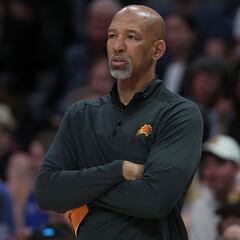NBA draft lottery 2023: what are ‘pick swaps’?
The NBA team franchises rely on this powerful tool for managing player transfers and strategically influencing upcoming draft selections.

NBA franchises greatly value their draft rounds. Each team has a first and second round in every draft, with higher rounds being more valuable. There are thirty picks in each round, which serve as significant assets for the team’s future. These picks allow teams to select talented young players and provide valuable market options.
Draft rounds are often a valuable part of transfers, serving as a key incentive for teams. This is especially true when a team trades a star player to start fresh and rebuild. In such cases, a strong batch of draft picks is highly sought after and considered a valuable asset. Conversely, teams focused on immediate success and winning now may trade away draft picks in favor of existing players. The quality of the player being traded for will determine the number of draft picks offered in exchange.
NBA:
Once the regular season ends or a team is eliminated from the title playoffs, they can transfer their picks. The market for trading picks is open until the winter shutdown, which allows teams to prepare for the next playoffs. However, there are limitations on which picks can be carried over. The “Seven Year Rule” only will enable picks to be traded for the next seven years, not beyond. This rule is in place to protect teams from inheriting mistakes made by previous executives and coaches. The “Ted Stepien Rule” also prohibits trading first-round picks in consecutive years unless the team receives another first-round pick in return from one of those two years. If this condition is not met, the team must send picks from non-consecutive years or a year when the draft has already passed.
One crucial consideration during the draft rounds is using protections in transfers. These protections allow teams to retain their picks if certain conditions are unmet. For instance, a round traded with top-10 protection means the sending team will keep it if it falls within the 1-10 range. These protections can be either highly restrictive or broad (such as top 3 protection or first-round protection), and they significantly impact the value of the picks. Additionally, if a pick is not ultimately transferred due to protection, its conditions are typically established, such as being prorated to another season or becoming a second-round pick.
The Ted Stepien Rule prevents the direct transfer of consecutive first rounds, leading teams to use pick swaps to bridge the gap. Pick swap involves the team with the lot deciding whether or not to trade their first-round pick with the other team. If the other team is in a worse position and has a higher pick, they will want to trade to secure the more valuable pick.
Related stories
Here’s an example: The trade between the Nets and the Celtics involving Kevin Garnett, Paul Pierce, and Jason Terry was a disaster for the Nets. The Celtics received three unprotected first-round picks in 2014, 2016, and 2018, a swap pick, and some complementary players. When the Nets performed poorly, the 2017 swap pick turned into a No. 1 pick, which the Celtics used to secure the top pick. They then traded it for the third pick and used it to select Jayson Tatum and a future first-round pick they used to invest in Romeo Langford.
Pelicans wound up using none of the pick swaps they got from the Lakers in the AD deal.
— Daniel Starkand (@DStarkand) April 9, 2023
Lakers still owe them one first rounder in 2024 or 2025, whichever the Pelicans choose. https://t.co/ZzbgAxQ3t6
Here’s another example: The Pelicans could swap picks with the Lakers this season because of Anthony Davis’ transfer in 2019. At the start of the year, when the Lakers were struggling and the Pelicans were close to leading the Western Conference, they likely would go through with the swap. However, the situation changed, and the Lakers finished the regular season ahead of the Pelicans.

